Seven powerful organic preservatives can protect your DIY perfumes naturally. Vitamin E oil prevents oxidation at 0.5-30% concentration, while jojoba and fractionated coconut oil create stable bases. Tea tree and lavender oils fight bacteria, as rosemary and grapeseed extracts provide antioxidant protection. Botanical extracts like aspen bark and anisic acid extend shelf life. Strategic combinations, proper storage in dark glass, and natural mineral additives offer even deeper levels of preservation.
The Power of Vitamin E Oil in Natural Perfume Preservation
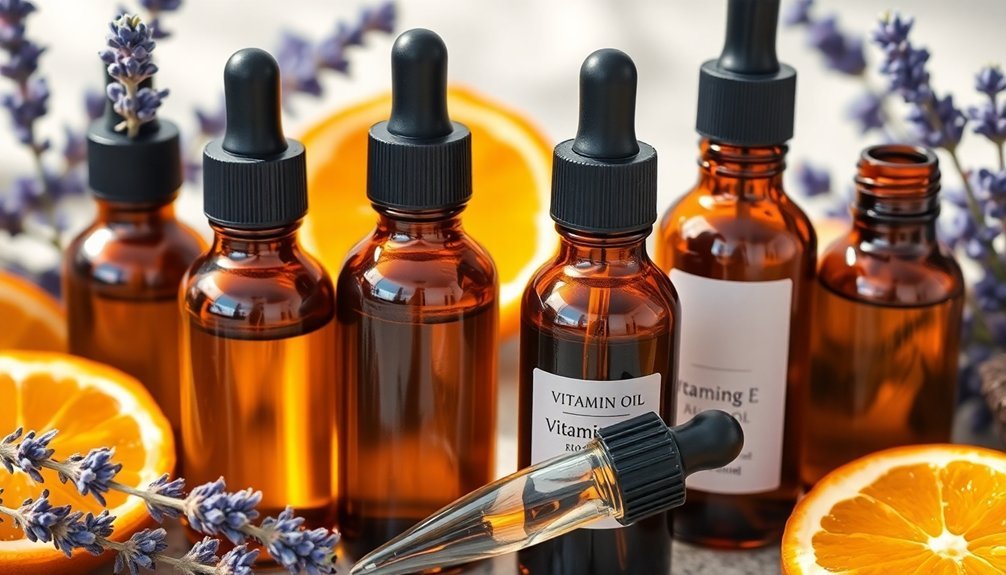
A quiet revolution in natural perfumery has made Vitamin E oil an essential ally for DIY perfume makers. While it's not actually a preservative, this powerful antioxidant plays an important role in protecting your essential oil blends from oxidation.
You'll need to understand that Vitamin E won't prevent bacterial or mold growth in your perfumes. Instead, it excels at keeping your oils fresh by preventing them from turning rancid.
You can add it to your formulations at 0.5% to 30%, but remember it's only suitable for oil-based creations, not water-based ones. For best results, purchase Vitamin E in small bottles to use within 6-12 months.
Store your Vitamin E oil properly in a cool, dark place or your refrigerator to maintain its effectiveness.
When you're blending, always test it for freshness first – spoiled Vitamin E can ruin your entire perfume batch.
Essential Carrier Oils as Base Preservatives
When selecting carrier oils for your natural perfume base, you'll need to take into account their individual shelf lives and antioxidant properties to guarantee your fragrance remains stable.
Jojoba oil and fractionated coconut oil stand out as excellent preservative bases due to their long-lasting nature and resistance to oxidation. A recommended dilution ratio of 15-30 drops per ounce of carrier oil ensures proper concentration and stability of the final perfume.
Understanding Oil Shelf Life
Three key factors determine the shelf life of essential carrier oils: fatty acid content, storage conditions, and natural antioxidant properties.
You'll find that oils high in unsaturated fatty acids last only up to 6 months, while those rich in Vitamin E or Lauric Acid can stay fresh for 1-2 years.
To maximize your oils' longevity, store them in dark glass bottles away from sunlight and heat.
While refrigeration works for most oils, don't refrigerate avocado oil.
Cold pressed oils retain more of their natural antioxidant properties that help preserve freshness.
You can extend shelf life by adding 1% Vitamin E oil to sensitive carriers like Rose Hip or Evening Primrose.
For even better preservation, try using nitrogen to displace oxygen in your containers.
Remember to check your oils regularly for rancidity and keep them in small bottles to minimize air exposure.
Antioxidant Properties Matter Most
Natural antioxidants found in essential carrier oils serve as powerful base preservatives for your DIY perfumes.
When selecting oils for your fragrance base, you'll want to prioritize those with strong antioxidant properties like cinnamon, ylang ylang, sandalwood, and neroli.
These oils contain specific compounds that combat oxidative stress and prevent rancidity. Cinnamon's cinnamaldehyde and eugenol protect cells, while ylang ylang's benzyl acetate and linalool preserve skin health.
Sandalwood's santalols and sesquiterpenes offer dual benefits of preservation and anti-aging, and neroli's limonene helps maintain product stability.
Remember that antioxidants won't protect against bacterial growth – they're specifically designed to prevent oils from oxidizing.
For water-based perfumes, you'll need additional antimicrobial preservatives like clove or oregano essential oils to guarantee complete product safety.
Combining Carriers For Stability
Selecting the right combination of carrier oils creates a stable foundation for your DIY perfume while enhancing its therapeutic benefits.
You'll want to blend oils that complement each other based on your skin type and desired fragrance profile.
For a balanced formula, combine a fast-absorbing oil like fractionated coconut or grapeseed with a richer oil such as jojoba or argan.
If you have combination skin, you'll benefit from mixing lightweight and nourishing carriers. For example, blend grapeseed oil with sweet almond oil at an 80% carrier concentration.
Remember to test small batches first, using 15-30 drops of essential oil per ounce of your carrier blend.
The right combination won't just preserve your perfume – it'll also guarantee better absorption and longevity while catering to your skin's specific needs.
Tea Tree and Lavender: Nature's Antimicrobial Duo
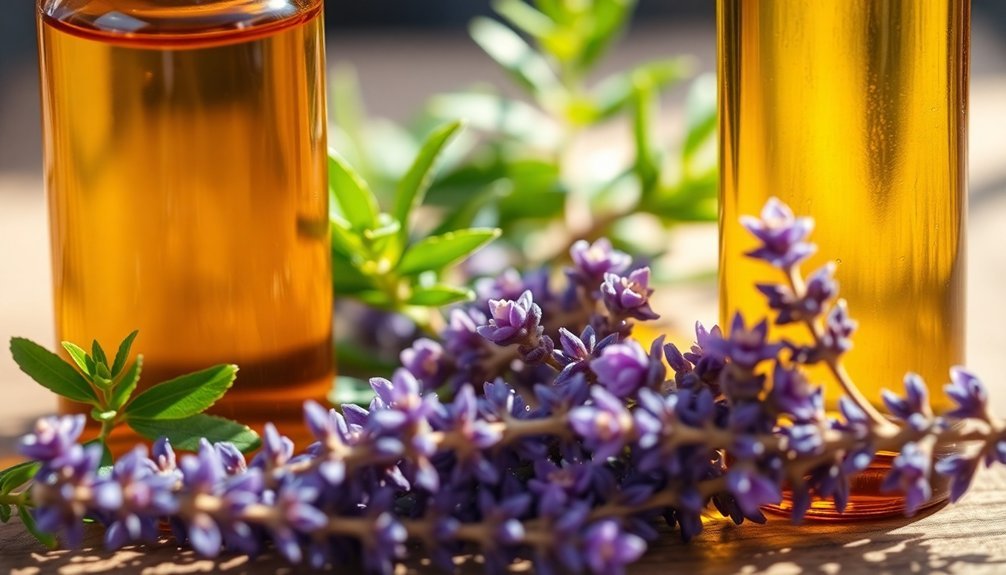
When creating DIY perfumes that stand the test of time, tea tree and lavender oils emerge as powerful antimicrobial allies.
Tea tree oil's main component, terpinen-4-ol, disrupts microbial membranes and stops bacterial growth, while lavender oil works synergistically with other preservatives to enhance their effectiveness.
You'll find these oils particularly effective at specific concentrations: tea tree oil works best between 0.5% to 5%, while lavender oil shows results at just 0.5%.
Together, they'll protect your perfume against common threats like Staphylococcus aureus and Candida sp. The Clone 88 variant of tea tree oil offers reduced skin irritation without compromising its antimicrobial properties.
To incorporate this natural duo, make certain you're measuring precisely and following safety guidelines to maintain both efficacy and skin-friendliness in your DIY perfume formulations.
Botanical Extracts for Extended Shelf Life
Botanical extracts represent an essential frontier in natural perfume preservation, offering both antimicrobial protection and extended shelf life for your DIY formulations.
When selecting preservatives, you'll want to focus on proven options like Aspen Bark Extract combined with P Anisic Acid, or Geogard ECT for broad-spectrum protection. These natural alternatives work effectively while maintaining your perfume's organic integrity.
- Use Aspen Bark Extract with P Anisic Acid at pH 4.5-5.5 for best results
- Consider Geogard ECT at 1% concentration for reliable protection across pH 3.0-8.0
- Choose high-quality citricidals from reputable suppliers when seeking paraben-free options
Remember to test your preservative system's effectiveness and guarantee proper packaging – airless pumps work better than open containers for maintaining your perfume's freshness and preventing contamination.
Rosemary and Grapeseed Extract Protection
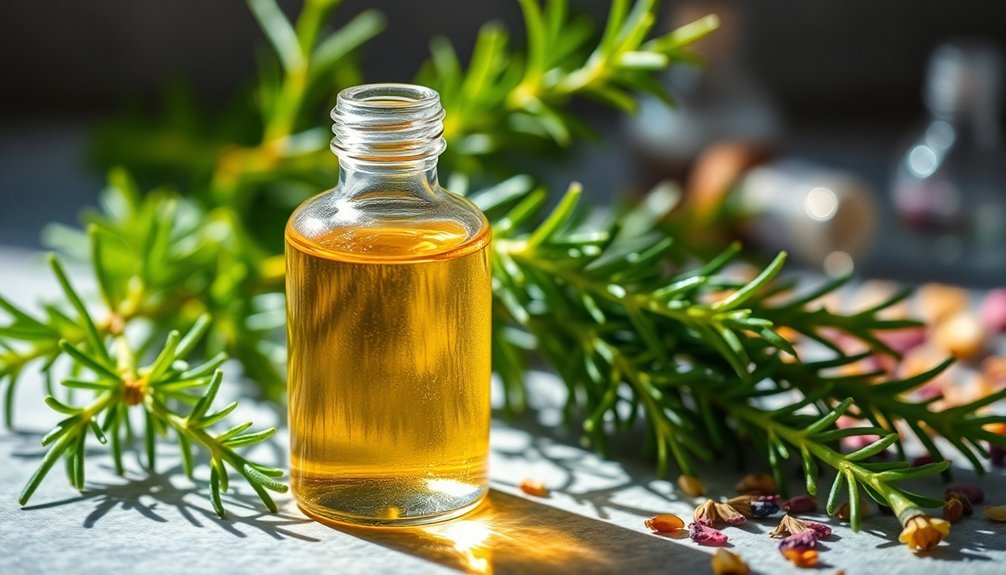
You'll find remarkable antioxidant protection in rosemary CO2 extract, which helps shield your DIY perfumes from oxidation through its powerful phenolic compounds like carnosol and carnosic acid.
When you combine rosemary's protective qualities with grapeseed extract, you're creating a natural defense system that works synergistically to extend your fragrance's shelf life.
Both extracts offer distinct benefits: rosemary excels at preventing oil rancidity at just 0.2-0.4% usage rates, while grapeseed contributes moisturizing properties and a subtle fruity note to your perfume formulations.
Antioxidant Power of Rosemary
Among natural preservatives for DIY perfumes, rosemary extract stands out as a powerhouse antioxidant that outperforms even Vitamin E in protecting fragrances from deterioration.
You'll find it's particularly effective in anhydrous formulations, with the ability to stabilize and dissolve completely in most vegetable oils, even at temperatures above 200°C.
To maximize rosemary extract's benefits in your DIY perfumes:
- Add 0.2-0.4% of rosemary extract to your total formulation for ideal preservation
- Mix it directly into carrier oils to extend their shelf life naturally
- Dilute with a carrier oil first when using in powder-based products
The CO2 extract's rich carnosic acid content delivers superior antioxidant protection compared to other natural preservatives like sage or thyme, making it your best choice for maintaining fragrance freshness without toxic chemicals or heavy metals.
Natural Oxidation Defense System
When combining rosemary and grapeseed extracts in your DIY perfumes, you'll create a powerful natural oxidation defense system that prevents fragrance deterioration.
These natural antioxidants work together to inhibit lipid peroxidation and neutralize free radicals that can degrade your perfume over time.
You'll want to keep grapeseed extract (GSE) at a maximum concentration of 0.1% to avoid irritation while still benefiting from its protective properties.
This combination not only extends your perfume's shelf life but also reduces the formation of potential allergens and irritants that can develop through oxidation.
The synergistic effect of these extracts helps maintain your fragrance's stability and quality, ensuring your DIY perfume stays fresh longer while providing additional benefits like UV protection and anti-aging properties.
Grapeseed Stability Enhancement
Three key factors make grapeseed oil and rosemary extract a powerful stability-enhancing duo in DIY perfumes. When you combine these natural ingredients, you'll get better protection against oxidation while maintaining the oil's excellent absorption properties and neutral scent profile.
- Grapeseed oil serves as an ideal carrier base, blending seamlessly with essential oils while absorbing quickly into your skin without leaving a greasy residue.
- Rosemary extract's antioxidant properties help protect against cellular damage and oxidation, enhancing the stability of your perfume formulation.
- The combination offers a natural approach to preservation, though you'll still need additional preservatives for water-based formulations.
Remember to source both ingredients from reputable suppliers to guarantee you're getting pure, synthetic-free products for your DIY perfumes.
Dark Glass Storage Solutions for Oil Stability
Dark glass bottles serve as guardians of your precious perfume oils, offering superior protection against the damaging effects of UV light and environmental factors.
You'll find that amber or green glass blocks up to 99% of UV rays, preventing photo-oxidation that can alter your oil's scent and color.
Unlike plastic containers that may leach chemicals, glass remains chemically inert and won't contaminate your oils.
It also creates an excellent oxygen barrier, especially when paired with tight-sealing caps and narrow necks.
You'll maintain better temperature stability too, as glass provides superior insulation against fluctuations that can degrade your oils.
For ideal results, store your dark glass bottles in a cool place between 57°F and 70°F, away from direct sunlight and heat sources.
This approach can extend your oil's shelf life by up to 50%.
Combining Natural Preservatives for Maximum Effect
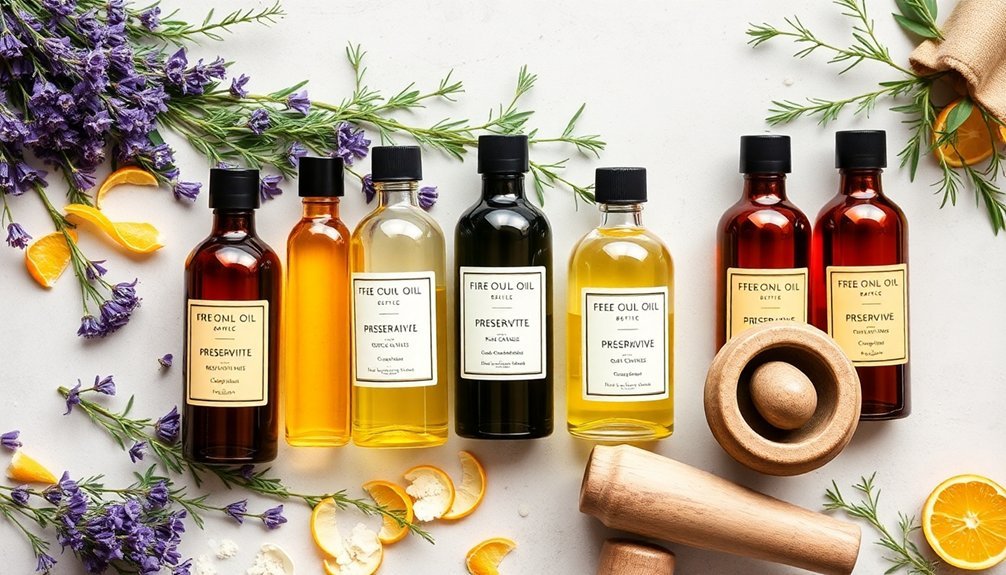
Creating a robust preservation system requires strategically combining multiple natural preservatives to enhance their protective qualities.
You'll get the best results by mixing essential oils with mineral preservatives and acidic components like apple cider vinegar. This combination creates a multi-layered defense against bacteria, mold, and other contaminants while maintaining your perfume's natural integrity.
- Combine 1 teaspoon of Bragg apple cider vinegar with antifungal essential oils like tea tree or lavender to create a powerful antimicrobial base.
- Add a pinch of Pink Himalayan salt to strengthen the preservative effects and enhance mineral content.
- Include rosemary oil extract or grapefruit seed extract as final protective elements, which also contribute beneficial antioxidant properties.
Remember to store your preserved perfume in dark glass containers and make small batches to guarantee maximum effectiveness.
Frequently Asked Questions
How Long Can Natural Perfumes Typically Last Before Showing Signs of Spoilage?
Your natural perfumes will typically last 1-3 years when stored properly, but you'll want to watch for changes in smell, color, or texture. Unopened bottles can stay fresh for up to 5 years.
Can I Mix Different Carrier Oils, or Should I Stick to One?
You can definitely mix different carrier oils to achieve desired properties. It's actually beneficial to combine them, as you'll get the unique benefits of each oil while customizing viscosity and absorption rates.
What Are Signs That Indicate My Natural Perfume Has Gone Bad?
Watch for changes in your natural perfume's scent becoming sharp or sour, color turning darker or cloudy, texture becoming thicker, and sediment forming at the bottom. These signs indicate it's time to discard it.
Should I Refrigerate My DIY Perfumes to Extend Their Shelf Life?
Yes, you'll want to refrigerate DIY perfumes, especially those with citrus and floral notes, to extend their shelf life. However, don't freeze them, and keep them in a consistent temperature to preserve their fragrance quality.
How Do Seasonal Temperature Changes Affect Natural Perfume Preservation Methods?
Seasonal changes can dramatically impact your perfumes. You'll notice faster degradation in summer heat and slower evaporation in winter. Keep them at stable temperatures year-round to prevent scent alterations and preserve quality.
In Summary
You'll find that combining these seven organic preservatives gives your DIY perfumes the best protection against oxidation and bacteria. Whether you're using vitamin E oil as your primary preservative or mixing several botanical extracts, don't forget to store your creations in dark glass bottles. With proper preservation techniques and storage, your natural fragrances can maintain their integrity for months to come.

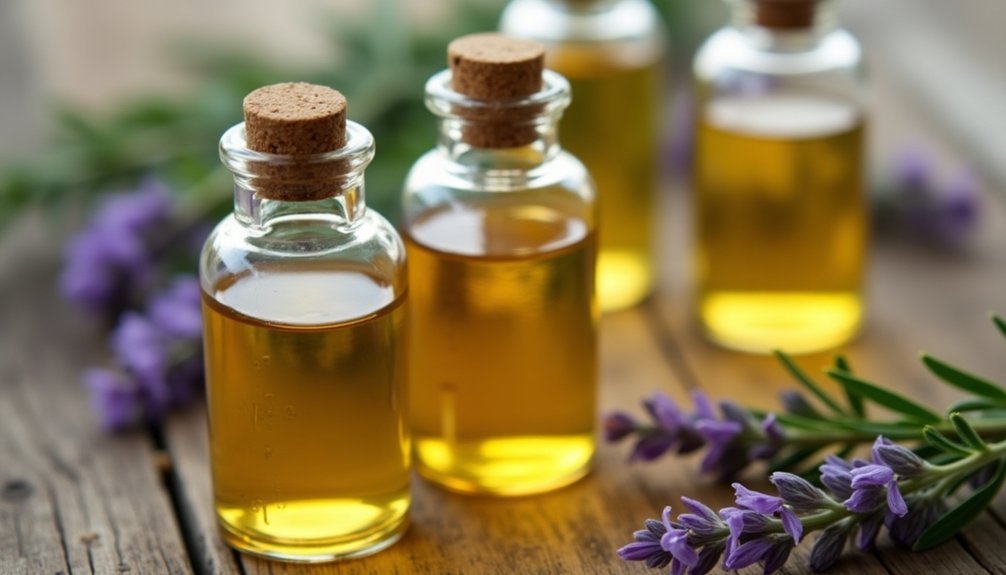



Leave a Reply